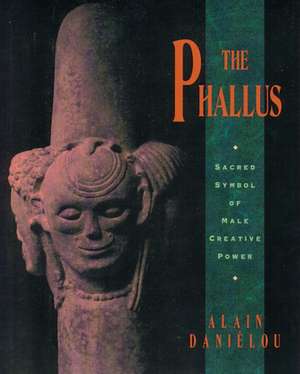The Phallus: The 17th-Century Manual on the Art of Concealment
Autor Alain Danielou, Alain Daniilou, Alain Dani?louen Limba Engleză Paperback – 31 oct 1995
Phallic imagery, in one form or another, may be found in the artistic traditions of virtually every world culture since prehistoric times. Alain Danielou here unveils the religious impulse underlying art that at first glance seems to have no purpose beyond the erotic.
Preț: 111.31 lei
Nou
Puncte Express: 167
Preț estimativ în valută:
21.30€ • 22.07$ • 17.78£
21.30€ • 22.07$ • 17.78£
Carte indisponibilă temporar
Doresc să fiu notificat când acest titlu va fi disponibil:
Se trimite...
Preluare comenzi: 021 569.72.76
Specificații
ISBN-13: 9780892815562
ISBN-10: 0892815566
Pagini: 128
Dimensiuni: 203 x 254 x 7 mm
Greutate: 0.37 kg
Ediția:Original
Editura: INNER TRADITIONS INTERNATIONAL
ISBN-10: 0892815566
Pagini: 128
Dimensiuni: 203 x 254 x 7 mm
Greutate: 0.37 kg
Ediția:Original
Editura: INNER TRADITIONS INTERNATIONAL
Notă biografică
Recenzii
"A great introduction to an often shunned aspect of religion."--Tony Mierzwicki, New Dawn, Mar-Apr 2006
Textul de pe ultima copertă
SEXUALITY / ART Worship of the phallus as a symbol of creative energy has been central to virtually every world culture, and strong traditions of phallic art exist throughout India, Egypt, Greece, and Northern Europe. Yet we in the West, hampered by modern taboos, have been unable to see this most fundamental of symbols for what it is--the image of the creator in mankind. Alain Danielou, the foremost authority on the art and spirituality of India and the classical world, here unveils the religious impulse underlying art that at first seems purely erotic. The Phallus surveys a wide range of art, myth, and cultural customs, examining phallic amulets of Neolithic man, standing stones of Europe, the mukha lingam of India, the obelisks of Rome and Egypt, and other representations of male fertility. Danielou shows the primal role played by ithy-phallic gods in such diverse mythologies as those of the Celts (Cernunnos, the Horned God), Greeks (Pan, Hermes, Priapus), and Hindus (Ardhanarishvara, the androgyne). He also explores the cults of Shiva and Dionysus in their role of bringing men into the communion with the creative forces of life. It is in this capacity--as a manifestation of the creator, a source of bliss and transcendence--that the phallus has its most powerful role in human symbolism. And, Danielou argues, if we are to maintain our link to the divine, it must assume this symbolic role again. Profusely illustrated with some of the world's finest examples of phallic art, The Phallus celebrates the expression of the masculine in the religious traditions of East and West. Dancer, musician, and scholar, ALAIN DANIeLOU (1907-1994) wrote more than thirty books about the philosophy, religion, and art of India and the Mediterranean. Following a series of successful careers, Danielou settled in India and spent fifteen years in the study of sanskrit, philosophy, and music. After numerous university appointments in India, he returned in 1963 to Europe, where he established the Institute of Comparative Music Studies. Danielou's other books include The Complete Kama Sutra; Gods of Love and Ecstasy; Myths and Gods of India; and Virtue, Success, Pleasure, and Liberation.
Cuprins
Sacred Symbol of Male Creative Power
Introduction
Part One: The Cult of the Phallus
1. Historical Sources
2. Symbolism
3. Representations of the Phallus
4. Indirect Representations of the Phallus
Part Two: The Ithyphallic God
5. The Lord of the Animals
6. The Guardian God
7. The Animal and Plant Forms of the God
8. Names and Aspects of the Ithyphallic God
9. The Survivals
Glossary of Sanskrit Terms
Bibliography
About the Author
Introduction
Part One: The Cult of the Phallus
1. Historical Sources
2. Symbolism
3. Representations of the Phallus
4. Indirect Representations of the Phallus
Part Two: The Ithyphallic God
5. The Lord of the Animals
6. The Guardian God
7. The Animal and Plant Forms of the God
8. Names and Aspects of the Ithyphallic God
9. The Survivals
Glossary of Sanskrit Terms
Bibliography
About the Author
